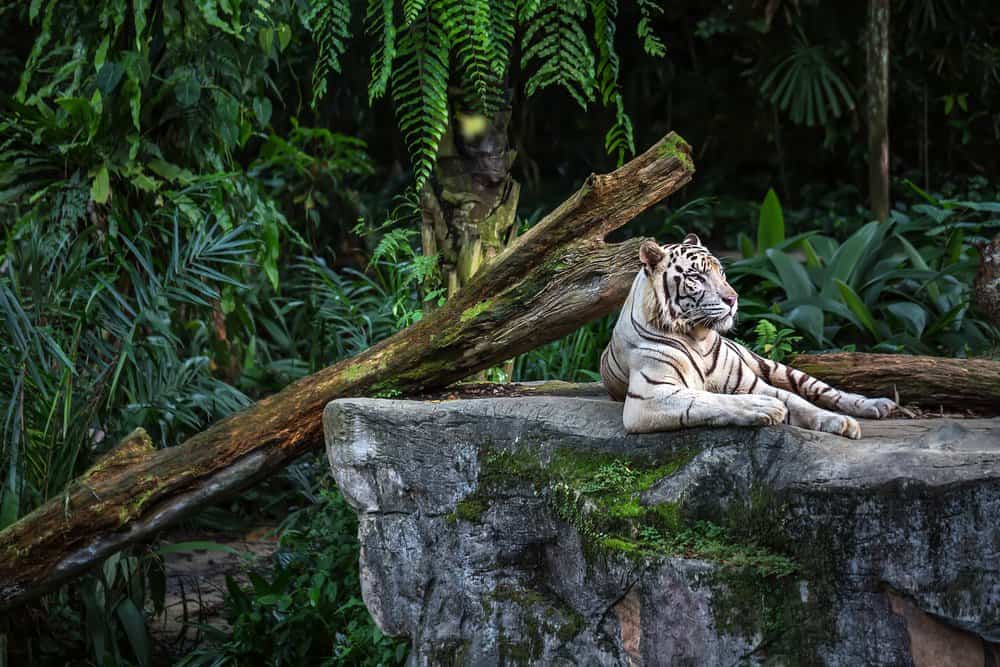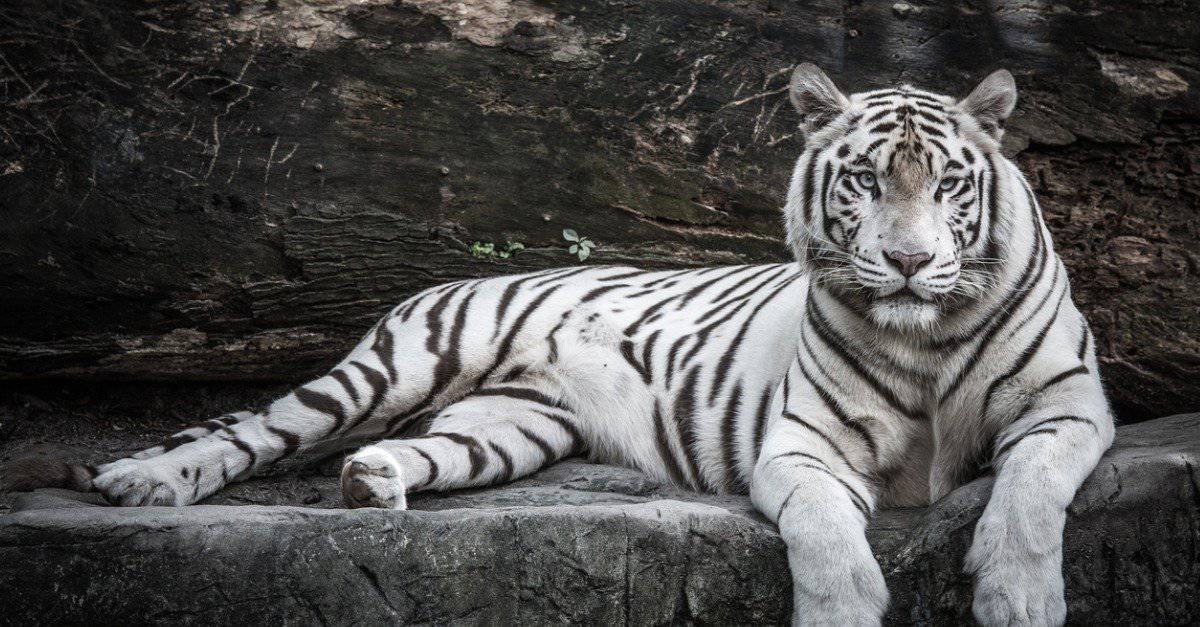From Yann Martel’s Life of Pi to Rudyard Kipling’s Jungle Book, the Bengal tiger stands tall in the human imagination. Its fierce, solitary nature, as well as its powerful body, have made it an object of fascination for millennia. Even more fascinating is its white counterpart, the white Bengal tiger. Unfortunately, given how many white tigers are left in the world, it is rare to see one at all.
Explore the wonder and majesty of the white tiger as we discover how many still exist on our planet!
What is a White Tiger?

White tigers are the result of genetic mutation in Bengal tigers.
©w1snu.com/Shutterstock.com
White tigers result from a genetic mutation called leucism in Bengal tigers. This recessive gene results in a white pelt. Unusual blue eyes also replace the typical golden or reddish-brown hue. However, this is not albinism; white tigers’ fur retains a certain amount of pigment. Both parents must carry the necessary gene to produce this type of offspring. Despite popular misconceptions, white tigers, or white Bengal tigers, are not a subspecies of Bengal, simply a variation.
White tigers retain their species’ signature black striping. Although humans consider this unique coloration desirable, it does little to help the tigers in the wild. It reduces their ability to camouflage themselves and makes catching prey more difficult.
Bengals of both colors are powerful creatures. Their bodies can reach lengths of 10 feet and weigh almost 600 pounds. However, they are not the largest! Siberian tigers are even bigger, with a maximum length of 11 feet and a top weight of almost 800 pounds. White tigers typically live between 10-15 years in the wild and up to 20 years in captivity.
There are 9 subspecies of tigers, including the Bengal and Siberian tigers. The other 4 still found today are the South China tiger, the Malayan tiger, the Indo-Chinese tiger, and the Sumatran tiger. Sadly, 3 subspecies have gone extinct: the Caspian tiger, the Bali tiger, and the Javan tiger.
How Many White Tigers Are Left in the World?

Around 200 white tigers exist in the world today.
©Muhammad Mahdi Karim / Creative Commons – Original / License
Only around 200 white tigers exist in the world today. All of them live in captivity in zoos, theme parks, or in exotic pet collections. There are currently no known white tigers left in the wild. Sadly, a trophy hunter killed the last one in 1958.
Including all subspecies, approximately 13,000 tigers are alive today. More than 5,000 still live in the wild. About 3,500 of those are Bengals, mostly found across India. Also, there are about 8,000 tigers surviving in captivity. Their keepers breed them to maintain their numbers. The United States alone keeps 5,000 of these tigers in zoos and theme parks. Occasionally, people even keep them as pets.
White tigers reproduce once every 2-3 years. They can produce litters of up to 5 cubs. Bengal tigers are fiercely solitary animals. After 18 months with their mother, the grown cubs leave to begin life on their own.
Where Do White Tigers Live?

White tigers are solitary, ferocious apex predators.
©LRBurdak / Creative Commons – Original
White tigers used to be found in the wild in India, Nepal, Bhutan, and Bangladesh. Today, they exist only in zoos and theme parks in countries such as America and India.
The preferred habitat of the white tiger includes tropical forests, jungles, and mangrove swamps. They require enough vegetation to camouflage themselves, as well as access to abundant sources of water.
White Tiger Diet and Predators
White tigers, like other Bengals, are ferocious, efficient predators. As carnivores, they rely on the meat of other animals to survive. Their diet includes deer, wild boar, cattle, and goats. They are apex predators with no natural enemies except humans.
Using the dense cover of the forest, these tigers stalk prey in near-silence, usually at night. Their keen hearing and sight allow them to navigate the darkness without difficulty. This puts their prey at a severe disadvantage.
In most cases, tigers are not known to hunt humans deliberately. They have an instinctive fear of human contact and will usually run away. However, they may attack if they feel that their territory, kills, or cubs are threatened. Rare examples of tigers becoming habitual man-eaters continue to inspire fear.
That said, isolated attacks occur because of human encroachment on tiger territory. As this is happening more and more frequently, tiger attacks in India are on the rise.
Are White Tigers Endangered?

White tigers are on the Endangered list.
©S.K Photos/Shutterstock.com
Unfortunately, white tigers are on the Endangered list. As long as there are Bengal tigers carrying the recessive gene, their white counterparts will not technically be extinct. However, the possibility of naturally-occurring white cubs becomes rarer and rarer as Bengal numbers decline. As white tigers are not a subspecies but rather a genetic variation, their survival depends upon the survival of Bengals.
The endangerment of white tigers can be attributed to several causes. Trophy hunting has traditionally been a major problem, as poachers seek the tigers’ fur, heads, and other body parts. Retaliatory killings for the deaths of people or livestock have also played a role. Sadly, the loss of their habitat through deforestation has made both Bengal and white Bengal tigers more vulnerable to extinction.
Some people desire white tigers as exotic pets, further contributing to the loss of these animals in the wild. Zoos also play a role, placing white tigers on display for visitors’ perusal.
White Tigers in Captivity

White tigers now exist solely in captivity, with only about 200 left worldwide.
©bezikus/Shutterstock.com
As white tigers now exist solely in captivity, it falls to their keepers to ensure Bengals continue to produce pale offspring. This is difficult, as the white pelt rarely occurs under normal circumstances. To facilitate this type of offspring, zoo keepers manipulate the breeding process. This involves only breeding tigers that share the recessive gene.
Unfortunately, this gene is not common in zoos’ limited populations. Zoos face the major problem of inbreeding with every tiger subspecies. Every white tiger in America can be traced back to a single male white Bengal, Mohan. This tiger was taken from the wild in central India as a cub in 1951 and was used to breed other white tigers until his death.
Inbreeding is universally acknowledged to produce unhealthy offspring with a multitude of problems. These may include spinal deformities, defective organs, and immune deficiencies, among others. Despite backlash from the environmental community, zoos are reluctant to stop inbreeding. This is due to the money their tigers bring in. Conservationists and groups like the World Wildlife Fund (WWF) insist that the focus should be on helping tigers breed in the wild, not on captive tigers.
As rare as they are majestic, white Bengal tigers are well worth the effort to preserve them and their orange Bengal counterparts.
Thank you for reading! Have some feedback for us? Contact the AZ Animals editorial team.








